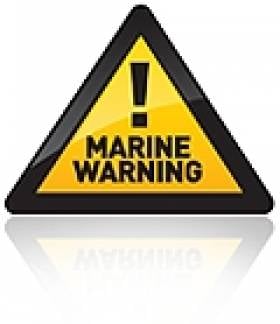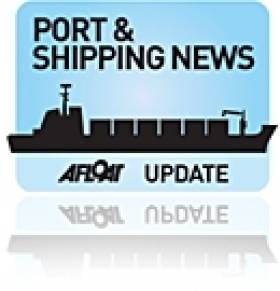Displaying items by tag: Co Dublin
Marine Notice: Rock Placement Offshore at Rush Beach
#MARINE NOTICE - The latest Marine Notice from the Department of Transport, Tourism and Sport (DTTAS) advises on rock placement operations offshore at North Beach in Rush, Co Dublin and in the Irish Sea.
Works commenced on 19 January to continue for around 14 days, subject to weather delays, undertaken by DPFPV Tideway Rollingstone (call sign PHYR) which is operating on a 24-hour basis.
The vessel is transmitting an AIS signal and will be keeping a listening watch on VHF Channel 16 at all times. It is also displaying appropriate day shapes and lights.
The works - which involve the deployment of survey ROV and fall pipe - will restrict the vessel's ability to manoeuvre, so all vessels in the vicinity (particular fishing boats) have been given warning to give the vessel and her equipment a wide berth.
Complete details including co-ordinates of work areas are included in Marine Notice No 4 of 2012, a PDF of which is available to read and download HERE.
Celebrating a 'New Chapter' in Ireland's Natural History
#MARINE WILDLIFE - "Until a mere couple of decades ago, virtually all we knew of the variety and distribution of the whales and dolphins around Ireland was judged from the catches of a short-lived Norwegian whaling station in north Co Mayo in the early 20th century and years of random recording..."
So writes Michael Viney in last Saturday's Irish Times, as he welcomes the 21th anniversary of the founding of the Irish Whale and Dolphin Group (IWDG).
"It can celebrate magnificent achievements," he writes, "both in turning so many Irish eyes seaward and in launching a new chapter in the island’s natural history."
As previously reported on Afloat.ie, the IWDG will be hosting its 21st anniversary banquet at the Grand Hotel in Malahide this Saturday.
Over the past two decades, it has grown from its core work of creating a proper record of stranded cetaceans, to cataloguing the diverse array of living whales and dolphins that populate Ireland's waters today, adding "new knowledge" of "international interest" every year.
The Irish Times has more on the story HERE.
Bremore Survey Indicates New Push for Port Development
Drogheda Port Company is seeking tenders to carry out geological investigations off Bremore Head near Balbriggan, the Sunday Business Post reports.
The port company and partner Treasury Holdings had been working with Hong Kong-based Hutchison Whampoa on plans for a new port in the north Co Dublin area, set to have a starting freight capacity of 10 million tons per year.
Treasury Holdings says the survey is intended to help avoid developing on a location that could interfere with historic sites, after An Taisce voiced its opposition to any port scheme that would impact on an archaeologial site running from Bremore to the mouth of the River Delvin.
An Taisce is also opposed to another proposed site at Gormanston.
Drogheda Port Company CEO Paul Fleming could not be contacted by the Sunday Business Post to comment on whether the tender indicates a decision to move forward with plans for a port at Bremore.
Minister for Transport Leo Varadkar said he supported the bid to develop a new facility at Bremore, after a previous move to extend the boundaries of Drogheda port were halted by legislative limits that have since been amended.
The Sunday Business Post has more on the story HERE.
New Life for Bremore Port Development
Drogheda's port company has redrafted its plan to develop a €300 million deepwater harbour in north Dublin.
The semi-State Drogheda Port Company previously failed to get approval from then Transport Minister Noel Dempsey when it first submitted proposals for the port at Bremore, near Balbriggan, in 2009.
The Sunday Business Post reports that the project would require a Ministerial Order to sanction the extension of Drogheda port's boundaries into Co Dublin under the Harbours (Amendment) Act 2009.
Previously any such extension would have been "legally problematic", in the words of Attorney General Paul Gallagher.
No planning application has yet been made, but partners in the venture are reported to be making preparations.
A public consultation on the previous proposals was conducted in September 2009.
National Yacht Club (NYC)

For all the latest news from the National Yacht Club click HERE
The Club
Founded on loyal membership, the NYC enjoys a family ethos and a strong fellowship which binds our members in a relaxed atmosphere of support and friendship.
Bathing in the gentle waterfront ambience of Dun Laoghaire on the edge of South County Dublin, the National Yacht Club has graced the waters of the Irish Sea and far beyond for more than a century.
Our famous burgee is a familiar sight in the sailing waters of Ireland, and the proud victory roll of our individual members and our Club is second to none.
Sailing Facilities
A slipway directly accessing Dun Laoghaire Harbour, over eighty club moorings, platform parking, fuelling, watering and crane-lifting ensure that we are excellently equipped to cater for all the needs of the contemporary sailor.
History
Although there are references to an active ‘club’ prior to 1870, history records that the present clubhouse was erected in 1870 at a cost of £4,000 to a design by William Sterling and the Kingstown Royal Harbour Boat Club was registered with Lloyds in the same year. By 1872 the name had been changed to the Kingston Harbour Boat Club and this change was registered at Lloyds.
In 1881 the premises were purchased by a Captain Peacocke and others who formed a proprietary club called the Kingstown Harbour Yacht Club again registered at Lloyds. Some six years later in 1877 the building again changed hands being bought by a Mr Charles Barrington. and between 1877 and 1901 the club was very active and operated for a while as the 'Absolute Club' although this change of name was never registered. In 1901 the lease was purchased by three trustees who registered it as the Edward Yacht Club.
In 1930 at a time when the Edward Yacht Club was relatively inactive, a committee including The Earl of Granard approached the trustees with a proposition to form the National Yacht Club. The Earl of Granard had been Commodore of the North Shannon YC and was a senator in the W.T. Cosgrave government. An agreement was reached, the National Yacht Club was registered at Lloyds, and The Earl of Granard became the first Commodore.
Sterling’s design for the exterior of the club was a hybrid French Chateau and eighteenth century Garden Pavilion and today as a Class A restricted building it continues to provide elegant dining and bar facilities. An early drawing of the building shows viewing balconies on the roof and the waterfront façade.
Subsequent additions of platforms and a new slip to the seaward side and most recently the construction of new changing rooms, offices and boathouse provide state of the art facilities, capable of coping with major international and world championship events. The club provides a wide range of sailing facilities, from Junior training to family cruising, dinghy sailing to offshore racing and caters for most major classes of dinghies, one design keelboats, sports boats and cruiser racers. It provides training facilities within the ISA Youth Sailing Scheme and National Power Boat Schemes.
The club is particularly active in dinghy and keelboat one design racing and has hosted two World Championships in recent years including the Flying Fifteen Worlds in 2003.
Berths with diesel, water, power and overnight facilities are available to cruising yachtsmen with shopping facilities being a short walk away. The club is active throughout the year with full dining and bar facilities and winter activities include bridge, snooker, quiz nights, wine tasting and special events.
Membership – enquiries may be addressed to: The Membership Secretary, The National Yacht Club – email: [email protected]
Reciprocal Clubs – The National Yacht Club has formal reciprocal membership arrangements with other clubs in Ireland and overseas. National Yacht Club members are welcome to visit our partner clubs and on introduction with the National Yacht Club membership card, our members may use the facilities of the host club subject to that club’s house rules. Likewise members of our reciprocal clubs are most welcome to visit the National Yacht Club where they may enjoy our facilities in the company of like-minded members.
Courses Offered – DINGHY: Up to Improving Skills, Advanced Boat Handling, Racing 1, Kites & Wires 1, and Adventure 1. POWERBOAT: 1, 2, and Safety Boat. KEELBOAT: Up to Improving Skills, Advanced Boat Handling, Racing 1, Kites & Wires 1, and Adventure 1.
(Details and photograph courtesy of the National Yacht Club)
National Yacht Club, Harbour Road, Dun Laoghaire, Co. Dublin. Tel: 01 280 5725, fax: 01 280 7837, email: [email protected] or [email protected]
































































